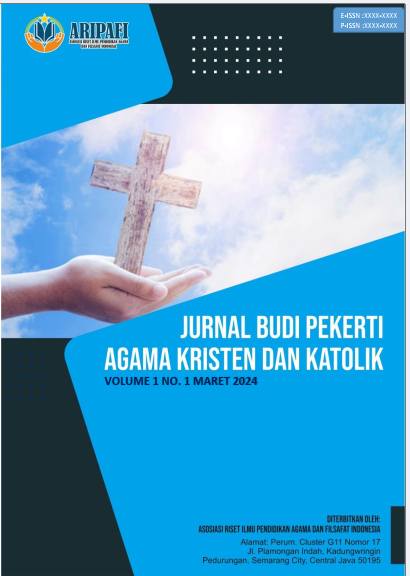Perpaduan Metode Debate dan Numbered Head Together terhadap Keaktifan Belajar dan Kepercayaan Diri Siswa pada Mata Pelajaran Pendidikan Agama Kristen
DOI:
https://doi.org/10.61132/jbpakk.v2i3.635Keywords:
Debate Method, Number Head together Method, learning activity, self-confidenceAbstract
In order for students to achieve the best learning outcomes, they must be involved in their studies and confident. Combining the debate method and the Number Head method together is one of the useful strategies to increase self-confidence and activity. If the Number Head Together method encourages students to actively participate in their education, the debate method seeks to develop students' self-confidence in voicing their opinions. The purpose of this study was to determine the difference in the influence of the experimental class and the control class. The Independent T-Test and Test 3 (Hotteling's T2 Test) were used in experimental research and hypothesis testing. From the first hypothesis test, the Sig value was produced. 0.068> 0.05, which means that there is no effect of learning with a combination of the Number Head Together - Debate Method and learning without treatment on student learning activity. While the results of the second Hypothesis test show a Sig value. 0.416> 0.05, namely there is no effect of learning with a combination of the Number Head Together - Debate Method on student self-confidence. And the results of the Hotteling T2 test show that the ρ-value for learning activity is 0.342 > 0.05, meaning that there is no difference in the average learning activity between students from both classes. The ρ-value for self-confidence is 0.049 < 0.05, meaning that there is a difference in the average self-confidence between students from both classes.
Downloads
References
Anderson, L. W., & Krathwohl, D. R. (2010). Kerangka landasan untuk pembelajaran, pengajaran dan asesmen: Revisi taksonomi Bloom. Yogyakarta: Pustaka Belajar.
Arikunto, S. (1993). Suatu pendekatan praktek (Edisi revisi II, p. 113). Jakarta: Rineka Cipta.
E, M. (2004). Kurikulum berbasis kompetensi: Konsep, karakteristik dan implementasi (p. 32). Bandung: Rosda Karya.
Harahap, A. N. I. (2023). Penggunaan video conference Zoom premium dalam pembelajaran kimia: Kajian persepsi siswa. INNOVATIVE: Journal of Social Science Research, 3(3), 1126-1136.
Huda, M. (2014). Model-model pengajaran dan pembelajaran (p. 87). Yogyakarta: Pustaka Pelajar.
Hutami, E. R. (2021). Kendala pembelajaran jarak jauh pada masa pandemi bagi siswa SD, guru, dan orangtua. Pinisi Journal of Education, 3(1). Retrieved from [source URL if available].
Lazuardi, D. R. (2022). Dampak pandemi Covid-19 terhadap kegiatan belajar mengajar daring. BIOEDUSAINS: Jurnal Pendidikan Biologi dan Sains, 5(1), 1-10.
Mantari. (2023). Penerapan metode debat untuk meningkatkan sikap percaya diri pada siswa sekolah dasar di Kabupaten Gowa. Pinisi Journal of Education, 3(5). Retrieved from [source URL if available].
Murniati. (2023). Pengaruh kepercayaan diri terhadap prestasi belajar siswa pada mata pelajaran ekonomi kelas X di SMA Negeri 2 Pasarwajo. Jurnal Akademik Pendidikan Ekonomi, 10(1), 1-15.
Nugraha, S. E. (2022). Pijar: Jurnal Penelitian Bidang Pendidikan dan Pembelajaran, 2(2), 57-64.
Palupi, D. I. (2023). Mengenal model kooperatif Numbered Head Together (NHT) untuk pembelajaran anak usia dini. Edukasia: Jurnal Pendidikan dan Pembelajaran, 4(1), 21-28.
Roestiyah. (2008). Strategi belajar mengajar (p. 149). Jakarta: Rineka Cipta.
Santoso, S. (2014). Panduan lengkap SPSS versi 20: Edisi revisi (p. 191). Jakarta: Elex Media Computindo.
Srijayarni, E. (2023). Problematika kepercayaan diri rendah siswa dan penanganan. Jurnal Akademik Pendidikan. Retrieved from [source URL if available].
Sugiyono. (2019). Metode penelitian kuantitatif, kualitatif, dan R&D (p. [specific page]). Bandung: Alfabeta.
Syah, M. (2009). Psikologi belajar (pp. 13-34). Jakarta: PT. Raja Grapindo Persada.
Widiyanto, J. (2010). SPSS for Windows untuk analisis data statistik dan penelitian (p. 51). Surakarta: BP-FKIP UMS.
Yulanda, M. T. (2020). Penerapan model pembelajaran kooperatif tipe Number Head Together untuk meningkatkan hasil belajar siswa pada pembelajaran tematik terpadu di sekolah dasar. Jurnal Pendidikan, 4(3), 2596-2604.
Zaini, H. (2008). Strategi pembelajaran aktif (p. 38). Yogyakarta: Insan Mandiri.
Zyra, S. N. (2022). Penggunaan e-learning berbasis Edmodo terhadap hasil belajar kelas 4 sekolah dasar. Jurnal PGSD: Jurnal Pendidikan Guru Sekolah Dasar, 15(2), 97-106.
Downloads
Published
How to Cite
Issue
Section
License
Copyright (c) 2024 Jurnal Budi Pekerti Agama Kristen dan Katolik

This work is licensed under a Creative Commons Attribution-ShareAlike 4.0 International License.





